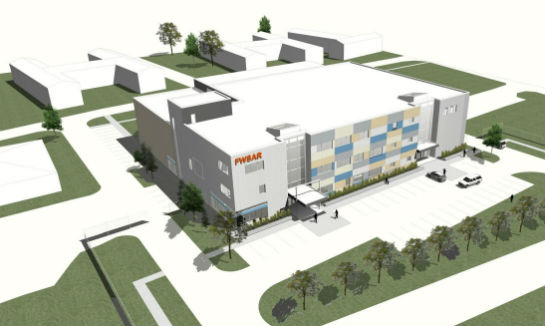Estimated reading time 7 minutes, 7 seconds.
The proposed 72,000-square-foot centre would house classrooms, simulators for flight, mission and maintenance, and a training hangar for a full-scale C-27J training mockup. Team Spartan Image
Canadian Forces Base Comox on Vancouver Island would get a new integrated flight and maintenance training centre if Team Spartan wins the contract to supply new fixed-wing search and rescue aircraft to the Royal Canadian Air Force (RCAF), the joint venture announced June 22.
Leonardo Aircraft (formerly Alenia Aermacchi) would provide its C-27J Spartan twin-engine turboprop, General Dynamics Mission Systems-Canada (GDMSC) would design and build the mission system, and DRS Technologies Canada, together with Spartan Aviation Services (SAS), would supply the training package built around the proposed centre at 19 Wing Comox.
The proposed 72,000-square-foot centre would house classrooms, simulators for flight, mission and maintenance, and a training hangar for a full-scale C-27J training mockup. While the basic structure, to be built by ATCO Frontec of Calgary, would be three storeys, the size of the aircraft mockup would extend into upper levels.
“By putting this state-of-the-art training facility in Comox, Team Spartan will meet the needs of the Royal Canadian Air Force by co-locating with the rotary-wing search and rescue fleet that is already there, and it enables the Canadian Armed Forces to proceed toward a search and rescue centre of excellence,” Steve Lucas, a former RCAF chief of the air staff (2005 to 2007) and now strategic advisor to Team Spartan, said in a prepared statement.
He described the Comox location as ideal for its proximity to other military SAR training facilities. As well, the mountain ranges on the island and mainland and vast stretches of open water provide an ideal training environment.
As the training leader, DRS has developed what it described in the statement as “an integrated training solution which will combine top-tier training elements from established suppliers located across Canada.” Those include Bluedrop Training & Simulation of Halifax, which would provide courseware; as well, TRU Simulation + Training of Montreal would design and deliver flight training devices and the simulators.
Steve Zuber, DRS vice-president and general manager, said that, “Our approach will minimize long-term training costs, optimize training effectiveness and achieve the necessary throughput of operators and maintainers required to achieve the mission.” DRS would also be involved in standing up the FWSAR Operational Training Unit.
Team Spartan’s response to the government’s request for proposals for the fixed-wing search and rescue aircraft replacement program includes what the consortium said is “a commitment to deliver 100 per cent of contract value industrial offsets and benefits in the form of hundreds of long-term jobs and far-reaching investments in Canadian firms and technology. They include IMP Aerospace (aircraft modifications); KF Aerospace (maintenance, repair and overhaul); Rolls-Royce Canada; Standard Aero; CAE Inc.; Esterline CMC Electronics (avionics); L-3 WESCAM (sensor package); Flyht Aerospace Solutions; and Airdyne Aerospace.
This “host” of companies, he said, “will provide products and services that will turn this into a uniquely Canadian aircraft and program” which would be supported “right out to the retirement of the aircraft, which could be 30 to 40 years, given the track record that Canada has for retaining its fleets.” Moreover, “having full access to the intellectual property means that this Canadian-led venture will also be able to do work for other customers, providing the opportunity for even more high-value jobs for Canadians for years to come.”
The new aircraft would replace not only the Comox-based CC-115s but also at least 11 Lockheed Martin CC-130H Hercules search and rescue aircraft. First delivery of replacement aircraft would occur 36 months after a contract is signed, which puts the government and its bidders into a 2020 time frame.
Lucas was coy about actual numbers. “Canada has asked that we be careful about the release of certain information and that qualifies as one of them,” he replied during the teleconference. “We’re not sharing that at this moment. It’s a capability-based proposal and so each company was asked to come up with a number of aircraft, including spares, to be able to meet the requirement at both the three- and four-base options.”
However, he rejected the concept of having a split FWSAR fleet with different aircraft types for different missions. “We believe that our aircraft has all the qualities required.”
Pointing out that the Canadian Armed Forces averages 1,000 incidents annually, he said speed is the key to mission success, particularly in the area for which Canada is responsible: well out into the Pacific and Atlantic oceans as well as into the high Arctic.
Lucas also noted that “we’re in the final stages of a greater than 10-year effort to replace the existing fleet” but declined to criticize the procurement process, which has been fraught with a series of difficulties. But he said the delay had enabled Team Spartan to incorporate the latest technologies, so it may actually have worked in the bidder’s favour.
An RCAF crew of two test pilots and two support personnel conducted four or five evaluation flights of the C-27J in Turin, Italy, in March and there evidently were “no surprises,” Lucas said. “We believe our aircraft is the best combination of speed, maneuverability, cockpit visibility, space in the back of the aircraft – plus affordability.”
Skies questioned Lucas on the “affordability” element, noting that cost specifics on the competing bids were confidential. “We have structured our proposal, as best we can, to make it a winning proposal – and that is the best combination of technical performance, cost and value proposition,” Lucas replied. “Obviously you’re quite right; Canada will be the one making that determination after they’ve evaluated all of the proposals, but certainly we have experience in this matter and we believe that we have the best package.”

